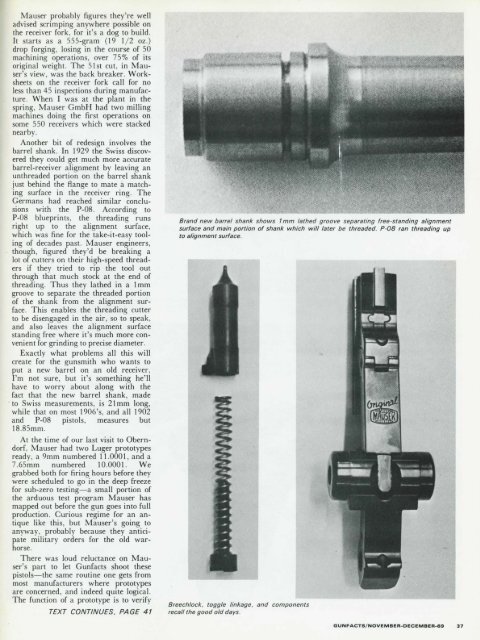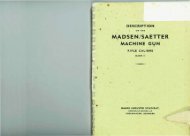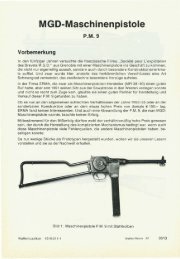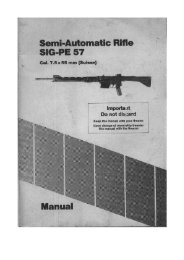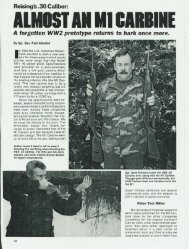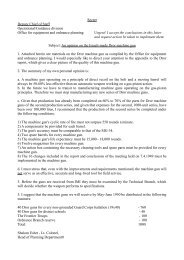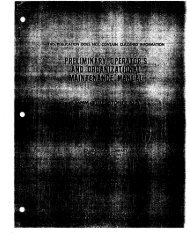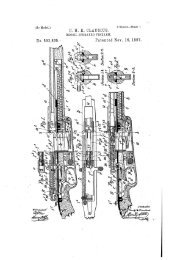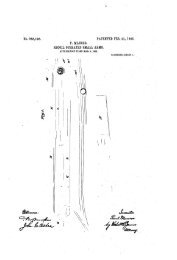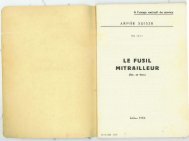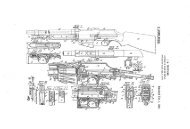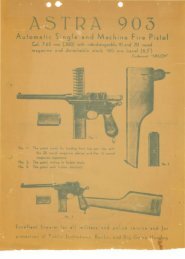The Parabellum Story (GunFacts).pdf - Forgotten Weapons
The Parabellum Story (GunFacts).pdf - Forgotten Weapons
The Parabellum Story (GunFacts).pdf - Forgotten Weapons
You also want an ePaper? Increase the reach of your titles
YUMPU automatically turns print PDFs into web optimized ePapers that Google loves.
Mauser probably figures they're well<br />
advised scrimping anywhere possible on<br />
the receiver fork , for it's a dog to build.<br />
It starts as a 555-gram (19 1/ 2 oz.)<br />
drop forging, losing in the course of 50<br />
machining operations, over 7So/o of its<br />
original weight. <strong>The</strong> 51st cut, in Mauser's<br />
view , was the back breaker. Worksheets<br />
on the receiver fork call for no<br />
less than 45 inspections during manufacture.<br />
When I was at the plant in the<br />
spring, Mauser GmbH had two milling<br />
machines doing the first operations on<br />
some 550 receivers which were stacked<br />
nearby.<br />
Another bit of redesign involves the<br />
barrel shank. In 1929 the Swiss discovered<br />
they could get much more accurate<br />
barrel-receiver alignment by leaving an<br />
unthreaded portion on the barrel shank<br />
just behind the flange to mate a matching<br />
surface in the receiver ring. <strong>The</strong><br />
Germans had reached similar conclusii:ms<br />
with the P-08. According to<br />
P-08 blueprints, the threading runs<br />
right up to the alignment surface,<br />
which was fine for the take-it-easy tooling<br />
of decades past. Mauser engineers,<br />
though, figured they'd be breaking a<br />
lot of cutters on their high-speed threaders<br />
if they tried to rip the tool out<br />
through that much stock at the end of<br />
threading. Thus they lathed in a 1 mm<br />
groove to separate the threaded portion<br />
of the shank from the alignment surface.<br />
This enables the threading cutter<br />
to be disengaged in the air, so to speak,<br />
and also leaves the alignment surface<br />
standing free where it's much more convenient<br />
for grinding to precise diameter.<br />
Exactly what problems all this will<br />
create for the gunsmith who wants to<br />
put a new barrel on an old receiver,<br />
I'm not sure, but it's something he'll<br />
have to worry about along with the<br />
fact that the new barrel shank, made<br />
· to Swiss measurements, is 21 mm long,<br />
while that on most 1906's, and all 1902<br />
and P-08 pistols, measures but<br />
18.85mm.<br />
At the time of our last visit to Oberndorf,<br />
Mauser had two Luger prototypes<br />
ready, a 9mm numbered 11.0001, and a<br />
7.65mm numbered 10.0001. We<br />
grabbed both for firing hours before they<br />
were scheduled to go in the deep freeze<br />
for sub-zero testing-a small portion of<br />
the arduous test program Mauser has<br />
mapped out before the gun goes into full<br />
production. Curious regime for an antique<br />
like this, but Mauser's going to<br />
anyway, probably because they anticipate<br />
military orders for the old warhorse.<br />
<strong>The</strong>re was loud reluctance on Mauser's<br />
part to let Gunfacts shoot these<br />
pistols-the same routine one gets from<br />
most manufacturers where prototypes<br />
are concerned, and indeed quite logical.<br />
<strong>The</strong> function of a prototype is to verify<br />
TEXT CONTINUES, PAGE 41<br />
Brand new barrel shank shows 1 mm lathed groove separating free-standing alignment<br />
surface and main portion of shank which will later be threaded. P-08 ran threading up<br />
to alignment surface.<br />
Breechlock, toggle linkage, and components<br />
recall the good old days.<br />
GUNFACTS/NOVEMBER-DECEMBER-69 37


